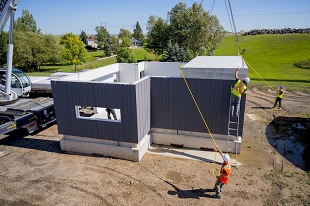 Friday, September 27, 2024
Friday, September 27, 2024  Friday, September 27, 2024
Friday, September 27, 2024 
Architects and contractors working in the far north, where the building season is short and the risk of water damage to building materials is high, have talked for some time about the transformative promise of modular construction.
Instead of slow on-site assembly, components like wall panels can be pre-fabricated in climate-controlled plants, then shipped and assembled quickly to prevent water damage and reduce the risk of thermal gaps.
So perhaps it’s not surprising that Nexii Building Solutions, a Vancouver-based pre-fab materials firm that recently raised $10 million in venture capital and brought on Vancouver’s high-profile former mayor, Gregor Robertson, originates with a pair of inventors in chilly Moose Jaw, Saskatchewan.
Last year, brothers Ben and Michael Dombowsky filed a patent for a pre-fabricated building panel they’d invented and developed over the past decade. Nexiite is made of sealed layers of cement and insulating material. They’re engineered so that the panels – ranging from walls to ceilings, doors and windows –can be fabricated in a plant and then assembled on site so as to minimize the sort of leakages (“thermal bridging”) that bedevil many new buildings.
To date, Nexii has used its light weight panels in six projects in Moose Jaw. But the firm, now armed with a war chest and patents, is expanding to Squamish, B.C., which has ambitious carbon reduction plans.
“This is a substantial leap forward in building technology,” says Stephen Sidwell, a long-time U.S. food industry executive with dual citizenship who came out of retirement to lead the expansion of Nexii.
While Sidwell won’t reveal what goes into the panels, he claims they’re significantly less carbon intensive than conventional exterior and interior materials, and avoid almost all the “worst-in-class” chemicals on an international roster known as The Red List. Because the panels are made in a plant, pre-packed and then shipped to job sites, construction times can be significantly reduced. That also reduces the use of cement trucks, which means cleaner and quieter construction sites, as well as reduced emissions.
Keep reading on CorporateKnights.com
Deadline for this week in Friday at noon
Join Construction Links Network